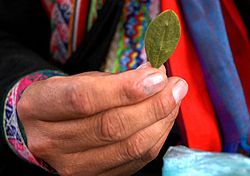Coca
Coca is a plant in the family Erythroxylaceae, native to north-western South America. The plant plays a significant role in traditional Andean culture. Coca leaves contain cocaine alkaloids, a basis for the drug cocaine, which is a powerful stimulant. Today the plant has many uses, including traditional use by Andean cultures to flavoring Coca-Cola products to use as an anesthetic.[2][3]
| Coca | |
|---|---|
 Erythroxylum novogranatense var. novogranatense leaves and berries | |
| Product name | Coca, coca leaves. |
| Source plant(s) | |
| Part(s) of plant | Leaves, fruits |
| Geographic origin | Andes[1] |
| Active ingredients | Cocaine, benzoylecgonine, ecgonine, others |
| Legal status |
|
History
Coca has been cultivated by Andean cultures for thousands of years.[4] Traditionally people would chew the leaf or soak it in hot water to make tea in order to get a small energy boost.[5] Coca was introduced to Europe in the 16th century. After its stimulating effects were described by a European doctor in the 19th century, people began to refine the leaves to get cocaine. As people began to learn more about cocaine it began to be banned in many countries. In 1961 the United Nations classified the coca leaf as a narcotic even though studies had shown the leaf itself was non-addictive.[6] This has led the United States to pressure coca-growing countries such as Peru and Bolivia to stop growing coca entirely.[2] These countries have responded by fighting the 1961 decision, trying to remove the coca plant from the list.
Coca Media
Cocaine, the psychoactive constituent of coca
Workers in Java prepared coca leaves. This product was mainly traded in Amsterdam, and was further processed into cocaine (Dutch East Indies, before 1940).
Llipta is used to improve extraction when chewing coca (Museo de la Coca, Cusco, Peru).
A cup of mate de coca served in a coffee shop in Cuzco, Peru
References
- ↑ Drug Enforcement Administration (April 23, 2013). "Coca: History". Internet Archive. Archived from the original on October 25, 2014. Retrieved February 16, 2015.
- ↑ 2.0 2.1 May, Clifford D (1988-07-01). How Coca-Cola Obtains Its Coca. https://www.nytimes.com/1988/07/01/business/how-coca-cola-obtains-its-coca.html.
- ↑ Grant, Stephen; Hoffman, Robert (August 1992). "Use of tetracaine, epinephrine, and cocaine as a topical anesthetic in the emergency department". Annals of Emergency Medicine. 21 (8): 987–997. doi:10.1016/S0196-0644(05)82942-7. PMID 1497171. Retrieved August 22, 2014.
- ↑ Rivera MA; Aufderheide AC; Cartmell LW; Torres CM; Langsjoen O (December 2005). "Antiquity of coca-leaf chewing in the south central Andes: a 3,000 year archaeological record of coca-leaf chewing from northern Chile". Journal of Psychoactive Drugs. 37 (4): 455–458. doi:10.1080/02791072.2005.10399820. PMID 16480174. S2CID 28661721.
- ↑ Weil, AT (Mar–May 1981). "The therapeutic value of coca in contemporary medicine". Journal of Ethnopharmacology. 3 (2–3): 367–76. doi:10.1016/0378-8741(81)90064-7. PMID 6113306.
- ↑ "Report of the Commission of Enquiry on the Coca Leaf" (PDF). United Nations Economic and Social Council: 31. May 1950. Archived from the original (PDF) on August 8, 2014. Retrieved August 4, 2014.







